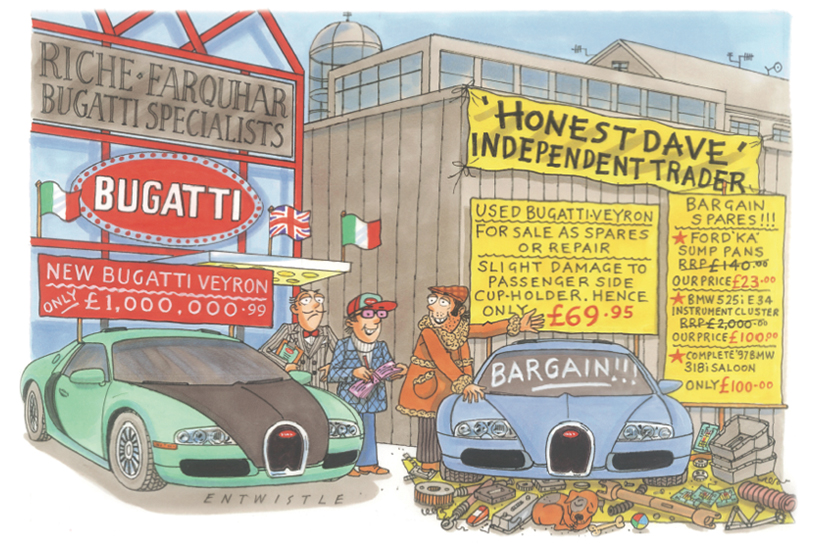Andrew Everett ponders modern parts prices and why are they so damn expensive?
Parts prices have always been a mystery to me. For the life of me, I just cannot think of a single manufacturer whose new parts prices are anything other than insane. A few years back, I needed a sump for a 1997 Ford Ka, the one with the old OHV Valencia based ‘Endura E’ motor. These pressed steel sumps, in the firing line of road debris and muck, followed the example set by the rest of the car and rusted merrily. You’d see a nasty big oil stain on the rusty sump, go to clean it up with a bit of sandpaper or a wire brush and suddenly the small oil leak became bigger and a lot more persistent.
Secondhand? They’re all rusty, forget it. New? Well, in 2007 (so almost ten years ago) they were about £140 with VAT and I doubt they’re any cheaper now from the ever benevolent Mr Ford. I mean – were they joking?
That sump took seconds to fabricate from five pence worth of cheap steel, 50 tons of one hit pressing and a cursory breath of satin black paint. Total cost of manufacture? At a guess, about two quid if that. So, a pattern part manufacturer comes along, sees a gap in the market and has an identical cheap, sheet steel sump banged out in China. Only from them, they’re 23 quid.
OK, so the bolt holes may require five minutes with a round file but the one I bought fitted just fine. Meanwhile, Ford are still trying to sell £140 sumps for £500 cars, sat there gathering dust. That’s a fail, as they say.
Ford isn’t alone in this of course – new parts from the likes of Toyota can be eye-wateringly expensive but in the case of the Ka’s Japanese competitors – Starlet, Jazz etc, they were properly made in the first place and some bloke in Toyota’s central stores would be scratching his head in bewilderment. “But why would you need to replace a Carina E sump? We haven’t sold one since 1999…”
Still, not much compares to some of the German manufacturer comedy parts prices that must involve a dartboard and some Friday afternoon inter office boozing. We’ll pick on BMW first of all because when you see some of the prices, you have to wonder how such a price was arrived at.
Let’s say you’re lucky enough to own a 1993 525i E34. The instrument cluster has gone on the fritz but luckily, it was designed in such a way that the circuit board that controls it all is on a hinge – after five minutes, the cluster is out and the circuit board unclipped and on the desk. Now to steel yourself for a price for a new one. It’s not going to be cheap after all. £150 is too cheap, so maybe £250? OK, that’s £350 with VAT. How expensive can it be? Well I’ll tell you. The price for this particular part contains four figures, and it starts with a 2. That’s right, it’s over two thousand quid. Two grand! So the next time you see a complete working cluster on Ebay for 100 quid that works, count yourself lucky and get it bought even if you don’t need it right now.
Meanwhile, £300 plus for a small heater matrix is steep, but should you want a basic, non airbag four spoke plastic steering wheel for an early E36 3-Series, take comfort in the fact that although they’re around 300 quid (really), they’ve got loads on the shelf waiting for the day a basic J-reg 318i is valuable. Good luck with that one chaps.
Used parts can be much the same. With the advent of US-style fixed price breakers in the UK pioneered by Copart, the days of the traditional scrapyard must be numbered. Rather than lying under a well supported car on clean hardstanding and removing a bit you’ll get for a very small fraction of the new cost at Copart, at Bob’s Breakers you’ll be trawling with wellies through a quagmire, removing an alternator from a Mondeo only to be told it’s two thirds the price of a recon unit with its 12-month warranty. And we have all had that famous comment from the scrappie: “You know how much they are new mate?” The best reply if you’re prepared to leave empty handed is “Yeah, and I know how much the car it came from cost new as well.”
As ever, if you have the space the best way to run an old car (especially a daily driver) is to buy a nice running but rotten or damaged example of the same thing. I run a 1998 E36 318i Touring estate and planning on running it for a few years, I went on the ‘Electronic Bay’ and won a lightly front ended 1997 318i saloon with full history and half the mileage for 100 quid. Add the four newish Uniroyals and the complete exhaust with a recent back box that went onto the Touring when the catalyst broke up internally and there’s my 100 quid straight away. You want the very nice cloth interior that’s of no use to me at all? Sixty quid you say? Sold! You want the straight, rust free four door shell after I’ve picked every last useable morsel from it for a hundred pounds? Sold!
That’s pretty much how to run a car for free, not be at the mercy of dealers and to be able to fix just about anything whenever you need to – that and scouring the net for new old stock stuff being given away. I mean, I fitted new front dampers to my 1989 730i 5000 miles ago, but another new boxed pair for £20 delivered? It was rude not to.





